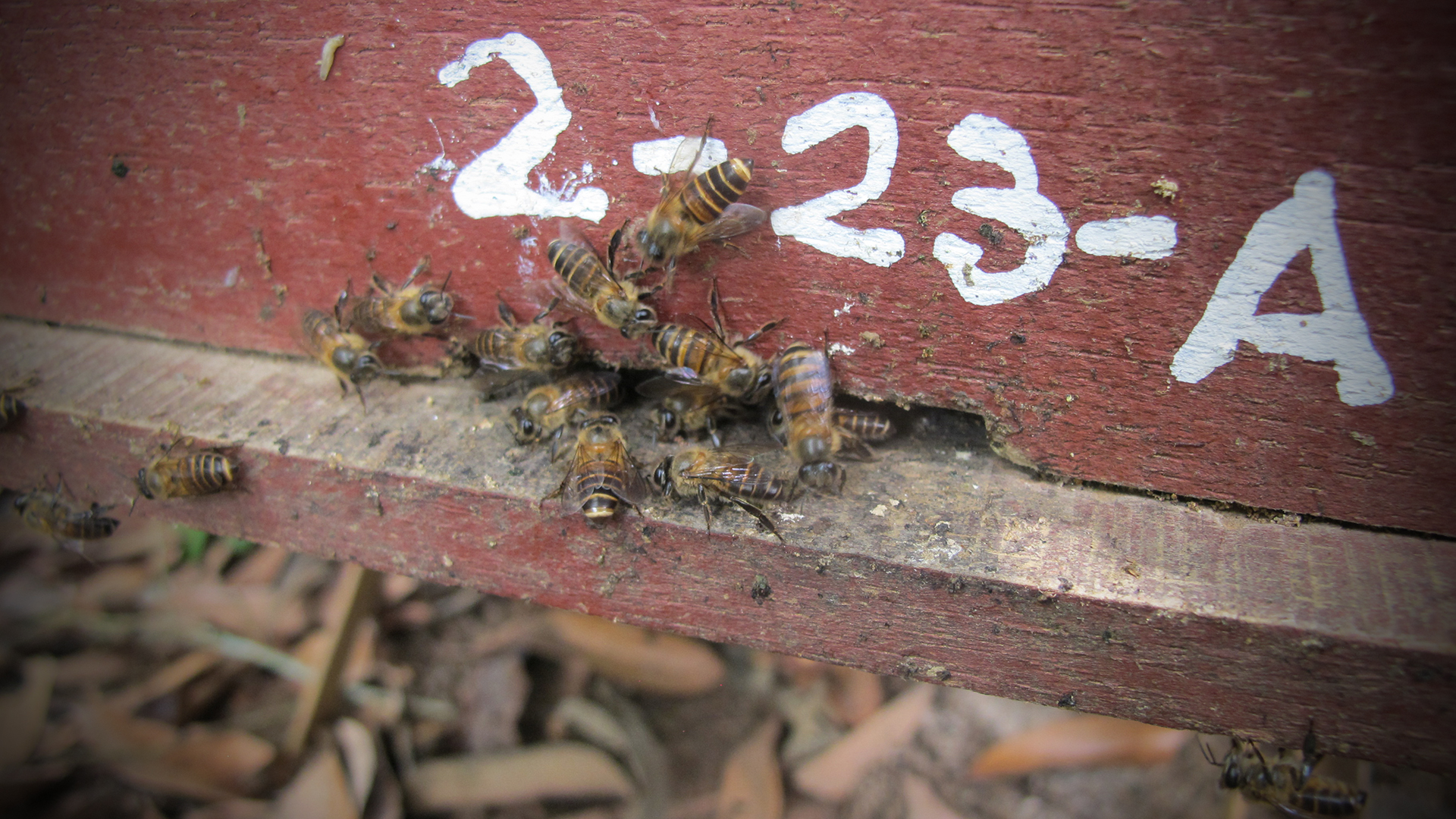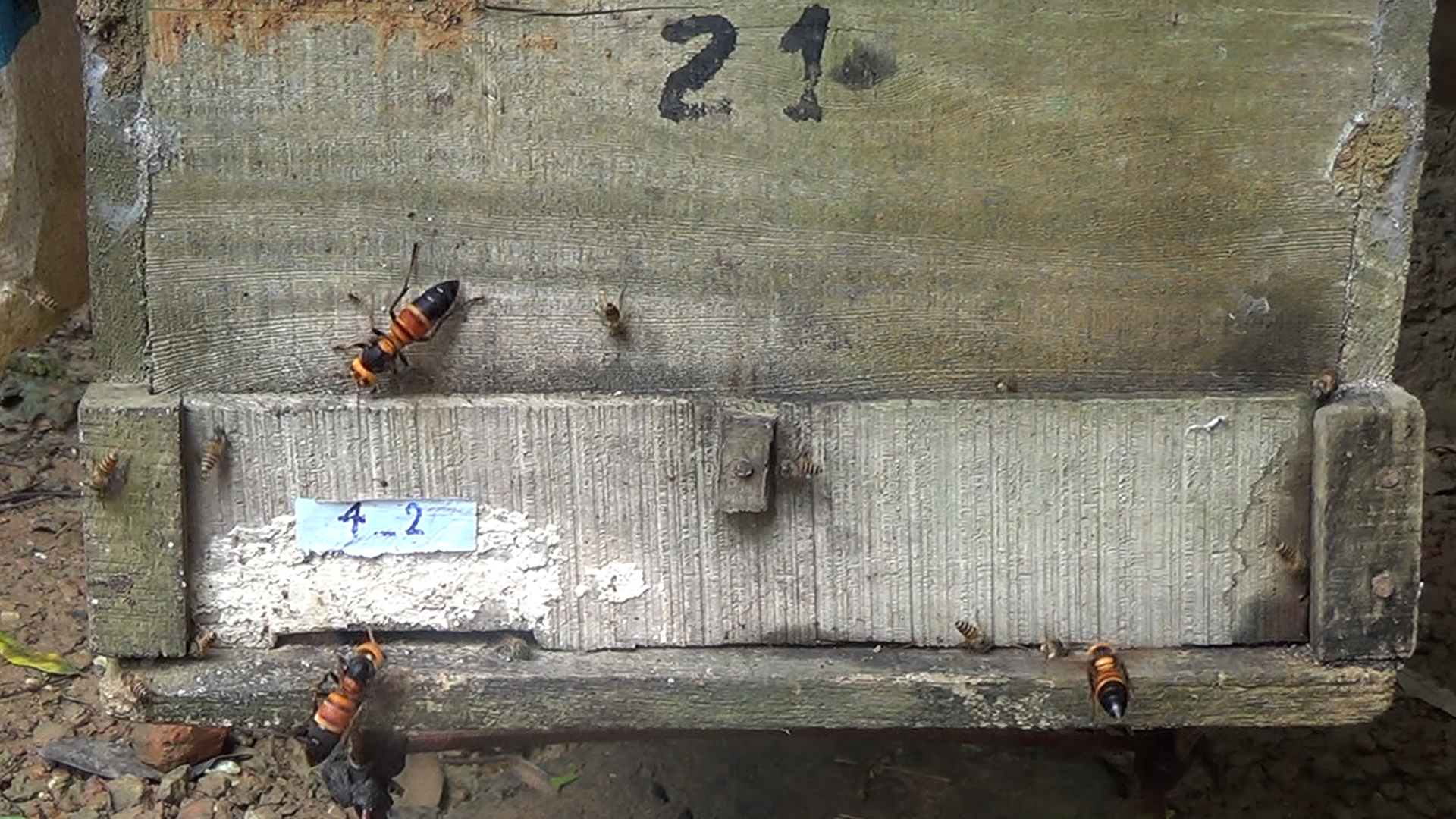Bees 'shriek' when attacked by giant cousins of 'murder hornets'
Giant hornets band together in groups to overwhelm honey bee hives.

When giant cousins of infamous "murder hornets" attack the hives of Asian honey bees, the bees produce a loud and frantic buzzing that resembles the panicked calls made by some types of birds and mammals if a predator is near.
Giant hornets (Vespa soror) are a sister species to so-called murder hornets (Vespa mandarinia). They're also one of the deadliest predators of Asian honey bees (Apis cerana). They attack hives in groups until they overwhelm the colony and kill or drive off the adults, then serve the bee brood as tender meals for their own hornet youngsters.
If these giant and aggressive hornets come calling, bees don't keep quiet about it, and their buzzy "shrieks" in response to the appearance of a giant hornet are louder and more intense than alarm calls about other hornets. The bees even produce a special type of "scream" in response to giant hornets; this bee-spoke response may help to alert the colony about an especially dangerous threat.
Related: Photos: Murder hornets will haunt your nightmares
Researchers first heard the screaming of the bees in Vietnam while investigating another of the bees' defensive maneuvers against giant hornets: smearing animal poop around the openings of their hives, said study lead author Heather Mattila, an associate professor in the Department of Biological Sciences at Wellesley College in Massachusetts.
"They collect dung from farm animals and apply that in spots around the entrances to repel hornets," Mattila told Live Science. "When we were there in the bee yard, I remember saying to my colleagues, 'These colonies are making a lot of noise.' So we started listening," she said. "It seemed like every time the giant hornets showed up — or right after they'd left — you could stand beside the colony and hear the bees inside freaking out."
To confirm what was going on, the researchers recorded video of hive exteriors and audio of the bees inside the hives, in colonies at three apiaries from late August through October 2013. They captured recordings of the hives during normal activity, and when the hives were assailed by giant hornets and by smaller hornet predators, Vespa velutina. The scientists then used audio-visualizing software to examine these colony soundscapes, identifying nearly 30,000 worker-produced signals.
Get the world’s most fascinating discoveries delivered straight to your inbox.

Their next step was to catalog different sounds that the bees were making. Finally, the researchers matched sounds to bee and hornet activity outside the hive to see if they could link certain buzzing patterns to specific triggers. Organizing "a mess of signals" from hives teeming with stressed-out bees was extremely challenging, "so it took us years to tease out what was going on," Mattila said.
A bustling space
Prior research has shown that bees communicate vibroacoustically, through a combination of airborne sounds that they sense through their antennae and vibrations that they detect with their legs. One of these signals is called a hiss, in which bees move their bodies and simultaneously vibrate their wings; another is known as a pipe, when a worker thrums her thorax and then butts her head against a hivemate or presses her body to a surface, thereby transmitting the signal.
It turned out that Asian honey bees hissed and piped to each other almost constantly, even when their hives were undisturbed. But when a giant hornet showed up, the hissing and piping ramped up and became cacophonous, the study authors wrote. Bees also produced specific pipes when giant hornets were near, which the scientists called "antipredator pipes." These signals were repeated in short bursts, but not in a regular pattern; there were also rapid frequency changes and an overall "harsh noisiness" to the sounds, Mattila said.

All of those acoustic features — irregular patterns and dramatic changes in frequency and amplitude — are also found in the attention-grabbing panic calls of animals such as meerkats and primates when they spy a deadly predator, the scientists reported. Bees even produced antipredator pipes in response to paper saturated with the chemical scent that attacking giant hornets use to mark beehives, though their response intensified when real hornets showed up, Mattila told Live Science. However, further study will be required to understand the role of antipredator pipes alongside honey bees' other defensive behaviors against giant hornets, she added.
Many types of hornets in the Vespa genus prey on Asian honey bees, so beekeepers in Vietnam protect their hives by standing guard with electrified tennis rackets, Mattila said. But of all the hornet predators, giant hornets are the biggest threat; just one attack can wipe out an entire colony, which could explain why bees have evolved to have a special signal for a giant hornet attack.
"Asian honey bees have been in a long war with these giant hornets," Mattila said. "It doesn't surprise me that they have pretty specific ways of communicating to try and be clear with each other about what they're facing."
The findings were published Nov. 10 in the journal Royal Society Open Science.
Originally published on Live Science.

Mindy Weisberger is an editor at Scholastic and a former Live Science channel editor and senior writer. She has reported on general science, covering climate change, paleontology, biology and space. Mindy studied film at Columbia University; prior to Live Science she produced, wrote and directed media for the American Museum of Natural History in New York City. Her videos about dinosaurs, astrophysics, biodiversity and evolution appear in museums and science centers worldwide, earning awards such as the CINE Golden Eagle and the Communicator Award of Excellence. Her writing has also appeared in Scientific American, The Washington Post and How It Works. She is the author of the book "Rise of the Zombie Bugs: The Surprising Science of Parasitic Mind Control," published by Hopkins Press.
